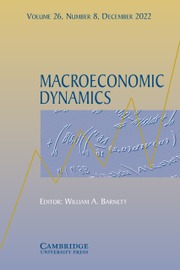No CrossRef data available.
Article contents
Liquidity trap, private behavior preference, and the micro-foundation of fiscal multiplier dynamics
Published online by Cambridge University Press: 03 February 2025
Abstract
We incorporate the liquidity trap and private behavioral preferences into a New Keynesian dynamic stochastic general equilibrium model to analyze fiscal multipliers. The results indicate that the influence of the liquidity trap on fiscal policy is driven by a combination of the interest rate transmission effect and the precautionary savings effect, showing a notable amplification of multipliers based on estimates from U.S. data. Furthermore, we examine two types of private behavioral preferences: habit formation and investor confidence. Habit formation significantly boosts short-term government spending multipliers while exhibiting diverse impacts on different types of taxation. Compared to superficial habits, deep habits result in flatter multiplier curves. Investor confidence, being highly sensitive to output fluctuations, enhances both spending and tax multipliers over the medium to long term. Additionally, the investor confidence channel slightly amplifies the expansionary effect of the liquidity trap on multipliers, contrasting with the impact of habit formation.
- Type
- Articles
- Information
- Copyright
- © The Author(s), 2025. Published by Cambridge University Press


